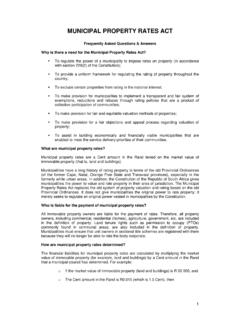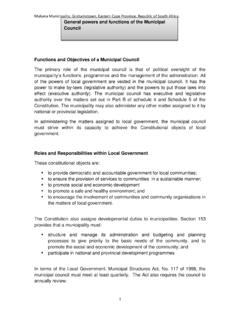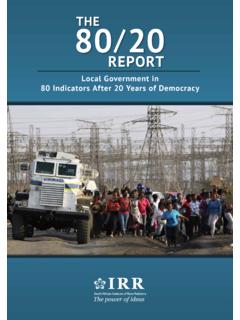Transcription of Revenue and expenditure trends in local government
1 213 Revenue and expenditure trends in local government Introduction The revenues and expenditures of municipalities determine their ability to deliver services. Weaknesses in Revenue and expenditure management could constrain the ability of a municipality to contribute to poverty reduction and economic development. They are also likely to reflect the existence of other governance challenges. This chapter reviews key trends in the revenues and expenditures of all 283 municipalities from 2003/04 to 2006/07 and future budget trends over the medium-term. Other chapters in this Review provide a more detailed analysis of specific expenditure functions. Simply reviewing the size of municipal revenues or expenditures provides little insight into the challenges that face municipalities, nor does it reveal much about the efficiency or effectiveness of a municipality.
2 Rising expenditures related to the delivery of a particular service may reflect an expansion of services to more citizens or increasingly difficult technical conditions, such as a dispersed population or a municipality reaching a specific stage in the life-cycle of its assets. But it may also reflect higher than average personnel costs or administrative overheads, weak expenditure control systems or inappropriate service standards. Inefficiencies in service delivery might also quickly translate into increased expenditures and perhaps even reduce the availability of resources to address the core objectives of poverty reduction and economic development. This chapter gives an overview of: local government in the system of public finance It is not enough to simply review the size of municipal revenues or expenditures 2008 local government BUDGETS AND expenditure REVIEW 22 Revenue trends expenditure trends key issues in municipal budgets.
3 local government in the system of public finance Table shows that the ratio of municipal expenditure to total government expenditure increases from per cent in 2003/04 to per cent in 2007/08. This reflects the strong growth in national transfers to local government , particularly associated with the 2010 FIFA World Cup. Over the medium-term the share of local government spending declines to per cent in 2009/10. This is due to the ending of the 2010 FIFA World Cup transfers and slower municipal infrastructure spending. Table also shows that municipal operating Revenue as a percentage of GDP was fairly stable between 2003/04 and 2007/08, but is set to decrease quite rapidly over the medium-term. It is apparent that this is not being driven by changes in property rates, since rates as a percentage of GDP remain constant at about 1 per cent.
4 Rather most of this trend can be attributed to the fact that national transfers remain largely constant in the medium-term. Table 3 .1 local governme nt e xpenditure to GDP, 200 3/04 200 9/102003/042004/052005/062006/072007/082 008/092009/10R mil l io nOutcome Estimate Medium-term estimatesExpen di tur eNational departments194 515 216 140 245 635 264 821 299 766 331 165 365 797 Provinces131 858 142 629 161 764 186 561 214 571 247 860 274 712 local government85 850 97 162 112 882 128 106 157 294 160 620 156 514 Total expenditure412 222 455 931 520 281 579 488 671 631 739 645 797 023 Municipal expenditure as percentage of total government expe expenditure as percentage of operating revenue73 832 87 369 96 000 106 056 118 405 122 710 127 705 Municipal re venue as a percentage of rates13 980 16 396 17 401
5 18 521 21 486 22 770 24 136 Property rates as percentage of 288 979 1 427 445 1 584 743 1 807 316 2 045 533 2 286 906 2 506 870 Source: 200 7 and 2008 Budget Review Revenue trends Municipalities are largely self-financing. This means that the bulk of their resources are raised from own Revenue sources such as taxes and service charges. This principle is an important feature of any democratic local government system. It ensures that municipalities are directly accountable to local residents for the functions they perform Municipalities are largely self-financing CHAPTER 3: Revenue AND expenditure trends IN local government 23and the services they provide. It empowers residents to play an important role in deciding on the services they prefer and are willing to pay for and ensures that municipalities remain responsive to the needs of their residents.
6 However, in South Africa there are two important dimensions to this basic principle. First, there is a structural imbalance between available local Revenue sources and the expenditure functions that are assigned to local government . Second, not all municipalities have the same capacity to raise revenues, as levels of poverty vary considerably and are particularly high in mostly rural municipalities. In practice, this means that while national government must provide financial support to all municipalities, such support needs to be directed to ensuring all citizens have access to basic services. Table shows that total operating Revenue of municipalities (including government grants) grew by 7 per cent annually for the period between 2003/04 and 2006/07 and is projected to further increase by per cent per year over the medium-term.
7 This growth is driven largely by increases in national transfers targeted at stepping up funding access to pro-poor basic services, increased funding for 2010 FIFA World Cup commitments and the replacement grant for the Regional Services Levies (RSC) which was abolished in 2006/07. Table 3 .2 M unicipal ope rating re venue, 2 003/0 4 2 009/1 02003/042004/052005/062006/072007/0820 08/092009/10R millionOutcome Estimate Medium -term estim atesOperating Rev enueProperty rates13 980 16 39 6 17 401 18 521 21 486 22 770 24 136 Service charges36 146 38 73 5 40 201 44 498 49 223 51 549 54 777 Regional Service Levies14 983 7 00 9 7 604 386 95 2 0 Investment revenue1 673 2 11 5 2 357 2 970 3 845 3 818 4 133 government grants8 980 13 74 2 17 398 27 223 26 571 28 311 28 491 Publi c contributions and donations44 588 664 695 Other own revenue8 025 8 78 4 10 375 11 763 17 184
8 16 260 16 167 Total revenue73 832 87 36 9 96 000 106 056 118 405 122 710 127 705 Percentage of total revenueProperty Service c contributions and own % RSC levies abolished from 1 July 2006. Interim replacement grant included in E quitable : National Treasury local gove rnment database Service charges share in total operating Revenue declines from 49 per cent in 2003/04 to per cent in 2009/10 mainly due to the sharp increase in national transfers. Despite this decreasing share, Revenue raised from service charges is budgeted to grow by per cent per year over the medium-term in real terms. At 42 per cent in 2006/07, service charges are the largest source of operating Revenue for municipalities 2008 local government BUDGETS AND expenditure REVIEW 24 At per cent of total operating Revenue in 2007/08, government grants are the second largest source of Revenue .
9 Table also shows that for 2006/07 and over the medium-term, the increase to transfers averages per cent, which is mainly attributable to the additional grants given to the host cities of the 2010 FIFA World Cup. Revenue raised through property rates grew by billion or per cent in real terms between 2003/04 and 2006/07 and is expected to grow further by per cent over the medium term. This is largely due to the implementation of the new rating system, where municipalities will charge households according to the market value of both the land and any improvements to it. Progress report on the implementation of the Municipal Property Rates Act Although the Municipal Property Rates Act (2004) took effect from 2 July 2005, the new property rating and valuation system only takes effect when a council has adopted its rates policy and has prepared the first valuation roll in terms of the Act.
10 Municipalities are required to bring their valuation records up to date within four years of the effective date of the legislation, between 1 July 2006 and 1 July 2009. As municipalities require between 6 to 18 months to put in place a new municipal valuation roll, only a limited number of municipalities implemented their first valuation in terms of the Act on 1 July 2006 and 1 July 2007. The majority of municipalities (approximately 90 per cent) are therefore targeting either 1 July 2008 or 1 July 2009 as the implementation date, as indicated in the table below (based on 266 municipal reports): 2006/07 implementation date = 4 municipalities 2007/08 implementation date = 23 municipalities 2008/09 implementation date = 77 municipalities 2009/10 implementation date = 162 municipalities Although national and provincial governments are responsible for monitoring and assisting municipalities with the implementation of the new property valuation and rating system, municipalities are primarily responsible for ensuring that property rates bills remain affordable.















